TLPA
TYPES OF ALTERNATIVE FUELS AND ALTERNATIVE FUEL VEHICLES (AFV)[1]
Cars, trucks and other mobile sources account for almost a third of the total air pollution in the United States according to the Environmental Protection Agency (EPA) which established vehicle emission standards for cars and trucks in the early 1970’s. Since that time, vehicle emissions standards have been made increasingly stringent to address the national air quality problem. However, in the course of the past few months, New York City, San Francisco, Boston and Seattle have issued mandates requiring all taxicab fleets to achieve certain city driving mileage per gallon requirements in the near future. There are numerous problems for the taxicab industry in meeting such mandates including:
- Availability of hybrid vehicles: a key component of hybrids, the battery to power the electric motor, is not readily available
- Infrastructure to support alternative fuel vehicles: except for areas in California and some large cities, compressed natural gas fueling stations are few and far between. As for hydrogen fuel stations, there are only 60 in service in the entire country.
- Small vehicle safety: most of the hybrid vehicles currently in production, led by the Toyota Prius, are much smaller than the ubiquitous Ford Crown Victoria raising concerns about the safety of passengers in accidents, the cost of insurance due to this higher liability exposure.
- Durability of smaller vehicles: the ability of vehicles to stand up to the wear and tear they face when being used as taxicab vehicles.
TLPA is developing an in depth paper coving the issues surrounding alternative fuel vehicles so its membership can make informed buying decisions. An excerpt from this paper covering the types of alternative fuels and alternative fuel vehicles follows.
The Alternative Fuels and Advanced Vehicles Data Center (AFDC, formerly known as the Alternative Fuels Data Center) provides a wide range of information and resources to enable the use of alternative fuels (as defined by the Energy Policy Act of 1992 www.eere.energy.gov/vehiclesandfuels/epact), in addition to other petroleum reduction options such as advanced vehicles, fuel blends, idle reduction, and fuel economy.
The following fuels are defined as alternative fuels by the Energy Policy Act (EPAct ) of 1992:
- pure methanol;
- ethanol, and other alcohols;
- blends of 85% or more of alcohol with gasoline;
- natural gas and liquid fuels domestically produced from natural gas;
- liquefied petroleum gas (propane);
- coal derived liquid fuels;
- hydrogen;
- electricity;
- pure biodiesel (B100);
- fuels, other than alcohol, derived from biological materials; and
- P-Series fuels.
In addition, the U.S. Department of Energy (DOE) is authorized to designate other fuels as alternative fuels provided that the fuel is substantially non-petroleum, yields substantial energy security benefits, and offers substantial environmental benefits. Also, as amended in January 2008, Section 301 of EP Act of 1992 defines AFVs to include:
- hybrid electric vehicles,
- fuel cell vehicles, and
- advanced lean burn vehicles.
The current choices for alternative fuel vehicles on the road today include:
Hybrid electric vehicles:
There are three types of hybrids:
- Single mode hybrids that are electrically powered at low speeds and gasoline powered at high speeds,
- Two mode hybrids which feature low and high speed electric variable transmissions, i.e., two sets of gears: one for the internal combustion engine and another set for the electric engine resulting in improved fuel economy in both city and highway driving and are adaptable to gasoline, diesel or E-85 engines regardless of the cylinder configuration,
- Plug In Hybrids which feature a large, high capacity battery that can be recharged by traditional hybrid methods and by plugging into a household current.
Most current hybrids (including Ford Escapes and Toyota Priuses) are of the single mode type, are very efficient in stop and go city driving, however, they cannot compete with the mileage of traditional gasoline or diesel alternatives in highway driving as the battery adds considerable weight to the vehicle. Also, sustained uphill driving may drain the battery. The replacement cost of the battery ranges from $5,000 for a Prius to $7,000 for a Ford Escape may make the vehicle too costly for a typical taxicab or limousine fleet vehicle.
E-85 Flexible Fuel Vehicles:
E-85 is a mixture of 85% ethanol and 15% gasoline which produces fewer emissions than gasoline. Flexible fuel vehicles can run on either E-85 or gasoline. The added vehicle cost is very low and E-85 is as much as 50 cents per gallon cheaper than regular unleaded. It has a higher octane than gasoline so vehicles can be tuned for higher performance. On the other hand, fuel mileage is lower compared to gasoline and diesel (by 10 15%).
Only 1,134 of 170,000 public service stations sell E-85 (one of 170) and retail gas outlets are being slow to invest the thousands of dollars it takes to add E-85 capacity. Also, the majority of ethanol is derived from corn although new technologies will allow for production from biomass waste facilities. Ethanol is expensive to produce and some analysts say its increased production has contributed to an increase in food prices. Saab offers Saab BioPower engines that run on E-85 in both its 9-3 and 9-5 range of models. Saab has also developed the Saab BioPower Hybrid Concept, the world’s first hybrid vehicle without fossil fuel emission.
Biodiesel Fuel Vehicles:
Biodiesel produces fewer emissions than pure petroleum diesel. Biodiesel is a form of diesel fuel manufactured from vegetable oils, animal fats, or recycled restaurant greases. It can be used in its pure form (B100) or blended with petroleum diesel (B20 - twenty percent biodiesel and 80% petroleum diesel. B20 is the most common biodiesel blend in the United States.
Using B20 provides substantial benefits (www.eere.energy.gov/afdc/fuels/biodiesel_benefits.html) but avoids many of the cold weather performance and material compatibility concerns associated with B100. In January 2001, the Biodiesel Final Rule made it possible for fleets to earn EP Act credits for use of biodiesel blends of at least 20%. This rule does not make B20 an alternative fuel, but gives one credit for every 450 gallons of pure biodiesel used in biodiesel blends. B100 is biodegradable and produces less air pollutants than petroleum based diesel. It can be used in any diesel engine with little or no modifications. The bio portion is domestically produced from non-petroleum, renewable resources. However, it is less available than gasoline and diesel (roughly 1,000 filling stations nationwide). It has lower fuel economy and power (10% lower for B100 and marginal for B20) it is even more expensive than regular diesel and B100 is not suitable for use in low temperatures.
Natural Gas Fuel Vehicles:
Natural gas burns cleaner, more efficiently and completely than gasoline or diesel fuel, producing far fewer toxic pollutants and greenhouse gas emissions. Natural gas is a fossil fuel comprised mostly of methane. Methane is derived from a variety of sources such as oil shale, coal, natural gas or agricultural waste. Methanol can also be derived from landfills (LFG). There are two main natural gas fuel types: Compressed Natural Gas (CNG) and Liquefied Natural Gas (LNG), i.e., Propane.
- Compressed Natural Gas (CNG) is more than $1.00 cheaper per gallon vs. regular unleaded gasoline. In April 2008, the equivalent of a gallon of CNG averaged $2.04 compared with $3.53 for a gallon of gasoline. A newly developed home fueling appliance (Phill) by a company, FuelMaker, partly owned by Honda, allows drivers to fill their vehicle using the natural gas they use to heat their homes. Phills cost more than $4,000 and the installation cost is another $1,500. There is a 30-40% reduction in greenhouse gas emissions with CNG powered vehicles. CNG has a higher octane than gasoline so vehicles can be tuned for better performance and more than 90% of natural gas is domestically produced. Unfortunately, there are very few filling stations.
California has the largest infrastructure in the country with 450 total stations, however, only 160 are public access stations as most are installed and owned by private fleets. There are fewer than 2,000 CNG fueling stations nationwide. In the Washington, DC metropolitan area, for example, there are only four filling stations that offer CNG. CNG vehicles require a greater amount of space for fuel storage than conventional gasoline vehicles (CNG = 5x more space; LNG (see below) = 2x more space). Therefore, the range per gas tank of a CNG powered vehicle is between 170 to 225 miles making it less than ideal for road trips especially with the limited refilling options. There are fewer than 120,000 CNG vehicles in the U.S. many are fleets owned by governments and corporations.
- The interest in propane (also known as liquefied petroleum gas or LPG) as an alternative transportation fuel stems mainly from its domestic availability, high energy density, and clean burning qualities. It is the most commonly used alternative transportation fuel and the third most used vehicle fuel behind gasoline and diesel. Propane produces up to 20 per cent fewer toxic pollutants and greenhouse gas emissions than gasoline vehicles. (See the testimonial on the benefits of propane from the Yellow Checker Star taxicab companies in Las Vegas above).
There are more than 200,000 propane powered vehicles in the U.S. It is less expensive than gasoline, but gets fewer miles to the gallon. For example, in July 2008, the average price of a gallon of regular gasoline was $3.91, the price of a gallon of propane was $3.14, however because of differing energy contents per gallon between gasoline and propane the price paid per unit of energy content can differ somewhat from the price paid per gallon. Therefore, while the price per gallon of gasoline was $3.91 in July, the price per an energy equivalent gallon of propane was $4.34 in July.
No propane fueled light duty passenger cars or trucks have been produced commercially in the U.S. since the 2004 model year. Gasoline and diesel vehicles can be retrofitted to run on propane in addition to regular fuel at a cost of $3,400. Less readily available than gasoline and diesel, there are 2,500 propane refueling stations nationwide. See the U.S. Department of Energy’s Alternative Fuels and Advanced Vehicles Data Center (AFDC) for more information. www.eere.energy.gov/afdc/fuels/propane_alternative.html
Hydrogen powered fuel cell vehicles have been in development for years and use a sophisticated electrochemical energy conversion device similar to a battery. The power is then put to the wheels via an electric motor. The fuel cell converts hydrogen and oxygen into water and in the process produces electricity. Despite the appeal of fuel cell cars, an affordable, commercially available model is not on the horizon. However, there are a number of concept and test fleet vehicles on the road. Actress Cameron Diaz arrived at the 2008 Academy Awards ceremony in BMW Hydrogen 7, one of the first hydrogen powered luxury sedans ever made. Chevrolet is testing the Chevrolet Equinox SUV and Honda is testing the FCX Clarity (see below). Mazda, Audi, Dodge, Ford, GM, Mercedes, Toyota and Volkswagen also have fuel cell vehicles in various stages of development.
As of June 25, 2008 there were 69 operational Hydrogen Fueling Stations in the U.S. and Canada according to the Hydrogen Fueling Station database. There are another 41 stations in the planning stages. The realistic timeline for developing commercial hydrogen powered vehicle is still a question. It should be noted that in January 2008, Ballard Power Systems of Vancouver, the world leader in the manufacturing of hydrogen fuel cells, sold the company’s automotive fuel cell assets to Daimler AG and Ford Motor Company. John Sheridan, Ballard’s President and CEO stated, “This transaction lowers Ballard’s risk profile by addressing the realities of the high cost and long timeline for automotive fuel cell commercialization.”
Honda leased the first ever commercially available hydrogen fuel cell powered sedan to consumers in America and Japan in July 2008. The FCX Clarity is a completely new automobile designed from the drawing board to utilize a hydrogen fuel cell engine as its sole power source, according to the company. The appearance of the new Honda in showrooms in the world’s largest auto market is a sign that the automaker anticipates growing consumer interest in fuel cell technology which combines hydrogen with oxygen to produce electricity and whose only emission is water. “These are the same consumers who have largely embraced hybrid gas electric engines in the past decade. The pendulum is definitely swinging,” a spokesman for American Honda Motor Co., Christopher Naughton, said. Mr. Naughton said the company expects the majority of the new fleet will be leased in Southern California, the only area of the country with enough hydrogen refueling stations to allow widespread daily use of the car. The company will review all lease requests for the car on a case by case basis, he said. New York City devotees of fuel cell technology are resting their hopes on a special Shell station in White Plains, the closest hydrogen refueling spot to the city.
The FCX Clarity has a driving range of some 280 miles on a full tank of liquid hydrogen and gets a combined fuel economy of 74 miles a gallon “GEE,” or gasoline gallon equivalents, a term used by the Environmental Protection Agency to rate alternative fuel engines. Honda plans to offer three year lease arrangements on 200 FCX Clarity models. The $600 a month lease will include collision insurance and maintenance. The company’s original fuel cell vehicle traced its roots to an electric battery powered prototype refitted with fuel cell power packs.
For now, California is the center of the alternative fuel universe. Three Honda dealerships in the California cities of Costa Mesa and Santa Monica now comprise the world’s first fuel cell automobile dealer network according to the company. Among the first FCX Clarity customers is the actress Jamie Lee Curtis who lives in Santa Monica with her husband, the actor Christopher Guest. It’s only a matter of time until there’s enough demand in the Northeast for liquid hydrogen stations, Mr. Naughton said. “This is a private sector initiative on the part of Honda,” he said. American automakers are currently staging hydrogen fuel cell test programs, but none offers such a car for sale in dealerships.
The Big Three received funding to develop hydrogen based fuel cell vehicles after President Bush announced a $1.2 billion fuel cell initiative at his 2003 State of the Union Address. Part of the federal initiative was to develop a national infrastructure to produce, store, and distribute the amounts of liquid hydrogen needed to power the widespread use of fuel cell engines. A resident scholar with the American Enterprise Institute, Kenneth Green, said one of the drawbacks of fuel cell technology is that it is only as good as the availability of hydrogen. Because most of the world’s hydrogen is produced from coal power, the use of fossil fuels and the added costs of processing make the overall environmental promise of fuel cells doubtful, he said. “This is just ‘green’ showboating for Honda,” Mr. Green said, calling the FCX Clarity “a toy for 200 wealthy environmentalists. There’s just no infrastructure to produce the amounts they’d need beyond a fleet of 200 cars,” he said.
There are 60 hydrogen refueling stations in the U.S., the Department of Energy’s deputy press secretary, Jennifer Scoggins, said. One of the locations is part of a Shell station on Benning Road in Washington, D.C., which has a 1,500-gallon, double vault underground tank to supply hydrogen to the 77 fuel cell vehicles driven by Department of Energy employees. Part of the Department of Energy’s $1.2 billion initiative announced by President Bush in 2003 resulted in General Motors’ “Project Driveway” test program, where drivers in the New York, Los Angeles, and Washington, D.C., metropolitan areas were loaned the Chevrolet Equinox fuel cell powered vehicle.
The Shell station in Westchester County, equipped with a gaseous hydrogen storage tank, supplies the cars in the New York portion of General Motors’ Chevy Equinox test program. A Shell spokeswoman said it isn’t a retail station but a special fueling depot created in partnership with the city of White Plains. According to Shell, the owner of any properly registered fuel cell vehicle can stop and buy hydrogen in White Plains so long as the driver has completed a safety course at the depot. So, if New Yorkers are able to lease the new Honda FCX Clarity next month, they’ll be visiting the Shell depot in White Plains (a 45 minute drive from the city) whenever they need to refuel. Hydrogen currently costs about $5 a gallon, but proponents of the fuel say that it’s three times more efficient as gasoline.
Until now, a commitment to alternative fuel meant trading exterior styling for environmentally friendly technology under the hood. That’s why one of the more remarkable aspects of the FCX Clarity is that it’s a surprisingly sleek four door sedan. It shares its platform with Honda’s flagship, the Accord. Even though it’s three inches shorter from bumper to bumper, it’s comfortable 110 inch wheelbase is the same.
The American Enterprise Institute’s Mr. Green said American interest in alternative fuels would wane if gasoline prices return to last year’s levels. “There’s compelling evidence that oil will eventually fall back to the $60 a barrel range,” he said. “It’s a bubble; it’s not a matter of scarcity. People won’t switch from gas to hydrogen or anything else unless they really have to.” Added Mr. Green: “My money’s still on gas. Hey, the gas powered Hondas get great mileage. Why bother with hydrogen powered Hondas?” [2]
Electric powered cars: At the 2008 New York auto show , Mitsubishi showed the iMiEV an electric car based on the “i”—a rear wheel drive micro car that’s sold in Japan.
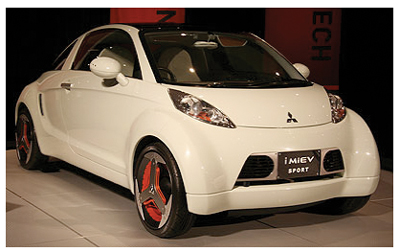
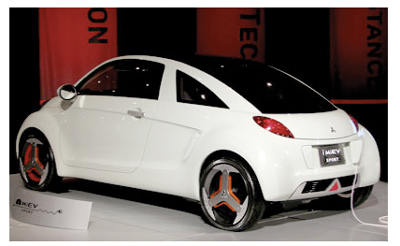
Mitsubishi iMiEV

Subaru has a fleet of electric micro cars, called the R1e, that are used by the Tokyo Electric Power Company. Nissan is also testing an electric- powered version of its Cube — its home market competitor to the original Scion xB. All three use lithium-ion batteries.
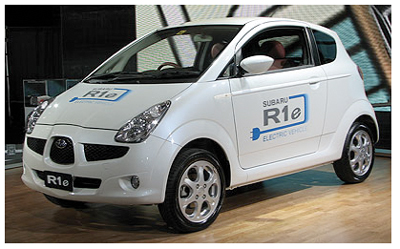
Subaru R1e
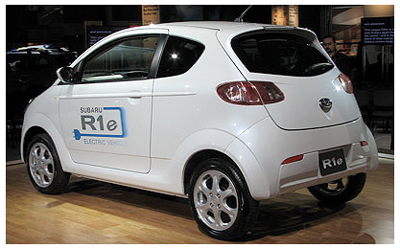
If any automaker is poised for real world mass market electric vehicle, it might be Nissan. Here’s why: The alliance between Nissan and French automaker Renault will soon be selling electric cars in Israel. Renault has recently partnered with a Silicon Valley based Israeli start up Project Better Place www.projectbetterplace.com (PBP) to supply electric powered Renault Megane sedans to be sold in Israel starting in 2011. PBP, in turn, will create a network of 500,000 battery charging and replacement stations throughout Israel as well as charging points in public parking garages and along streets.
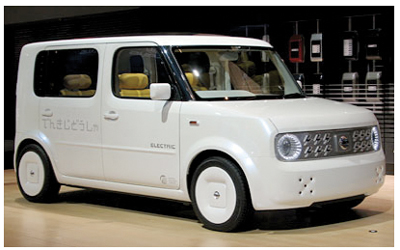
Nissan Denki
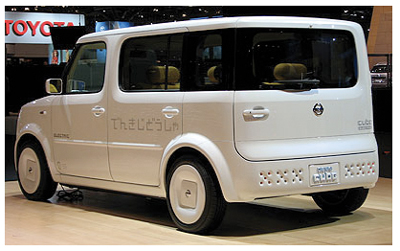
Israel seems an unlikely candidate to be the first country to adapt an electric car where environmental causes are not generally considered a top priority. However, it is a country where driving distances are relatively short which alleviates the main concern associated with electric vehicles’ inherently limited range. In fact, 90 percent of car owners drive less than 44 miles a day and the country’s three largest cities are within 100 miles of each other.
The electric Renault Megane, a sedan the size of a Volkswagen Jetta, is said to be able to accelerate from 0-60 mph in eight seconds and have a range of 125 miles. Purchase price is expected to be similar to that of an equivalent sized car with a 1.6-liter engine according to Carlos Ghosn, President and CEO of Nissan Motor Co. and Renault S.A., and Shai Agassi, CEO of Project Better Place. A generous tax subsidy by the Israeli government will help make the price of the car competitive.
Megane EV owners will subscribe to a battery replacement or recharging plan that’s based on their mileage. An onboard computer will indicate mileage left and the location of the nearest battery replacement or recharging spot. Removing and replacing the battery is planned to be performed by a robot. Operating costs are expected to be significantly cheaper than filling up with gasoline. This is no surprise as a gallon of regular unleaded costs about $6.90 in Israel.
A similar experiment is planned for Denmark, another country known for relatively short driving distances. In the Danish scenario, cars would be plugged in for recharging and that energy will be generated from renewable wind power. In Israel, most electric power comes from coal power stations; coal is neither a renewable source nor clean. Consequently, a mile covered by the electric Megane emits no CO2 compared to the 293 gram per mile for the conventional model; there would be added CO2 emissions at the power plant. The battery for the Renault is an advanced lithium-ion type developed by Nissan and NEC of Japan. This type of battery is commonly considered the next step from nickel metal hydride batteries used in today’s production hybrids. Li-ion batteries are still considered by many experts to be in their developmental infancy for automotive use and concerns about its longevity, charging time, and potential to overheat are still being addressed.[3]
During the Olympic games, General Motors aired commercials introducing the Volt as the pinnacle of GM’s fuel economy improvements and hybrid lineup. However, hundreds of GM engineers are working quickly to deal with the inevitable glitches from new technology. They must figure out how to keep the battery cool and adjust the car’s suspension so it performs well while carrying a 400 pound battery pack. GM has promised to begin selling the Volt in 2010 although industry experts wonder if it will be ready in time, whether enough batteries will be available to sell the cars in significant numbers, and whether the cost can be reduced to make the car affordable to the masses. GM has said the Volt will cost $30,000 to $40,000, and that it expects to sell 100,000 per year starting in 2011.[4]
In the meantime, a potential drawback for electric cars in the U.S., the strain recharging vehicles could have on the electric grid system. Utilities have to be aware that increasing gasoline prices could push sales of rechargeable electric vehicles well into the millions by 2020 which could stress the grid system. Other possible problems include electric vehicles getting larger and requiring far more electricity for recharging, and demands from people that their vehicles be recharged quickly drawing more electricity during peak times.
Diesel, while not an alternative fuel, has always been known for outstanding fuel efficiency with better mileage (by 25 percent to 40 percent) than gasoline. However, the kerosene like fuel and the engines that burn it were dirty, noisy, dawdling and even deadly, linked to increased risk of cancer and respiratory disease. That has all changed in part because of cleaner burning fuel. Its 2006 rollout had been mandated in 2000 by the Clinton administration. These engines have 97 percent less of the sulfur responsible for diesel engines’ sooty particulates. The low sulfur fuel hailed by the Environmental Protection Agency as a historic advance, has opened the door to sophisticated emissions controls that let diesel engines meet the strict pollution standards of California. Those rules, the world’s most stringent by far, require 2009 model diesels to be as green as gasoline or even hybrid models. Starting with the 2009 model year, several automakers have developed diesels clean enough to pass muster in all states including the big California and New York markets.
Under the hood, there is little to distinguish diesel engines from those that burn gasoline. Both use pistons, valves and electronic fuel injection, but the differences go beyond the form of petroleum that goes in the tank. Today’s gasoline engines ignite their fuel with a high voltage spark; diesels, also known as compression ignition engines, light the fire with the heat generated by squeezing the air in the cylinders to a far greater degree. This is one of their main advantages: a compression ratio of nearly 20:1, compared with a maximum of about 12:1 for gasoline. This means that diesel engines extract more power from their fuel.
The compression of a gasoline engine can’t simply be cranked up higher — the gasoline would burn erratically. Diesel fuel, a petroleum distillate, will tolerate those high cylinder pressures. Another reason diesels get better mileage: the fuel contains 12 percent more energy a gallon. While diesel currently costs 16 percent more than gasoline that premium is more than offset by mileage gains of 25 to 40 percent. Consumers would still save money with a diesel car, and they would fill it less frequently. The Mercedes E320 diesel sedan, for example, can cover roughly 700 highway miles on a tank. Next-generation leandiesel models (certain 2009 models) are also eligible for federal tax credits of up to $1,300.[5]
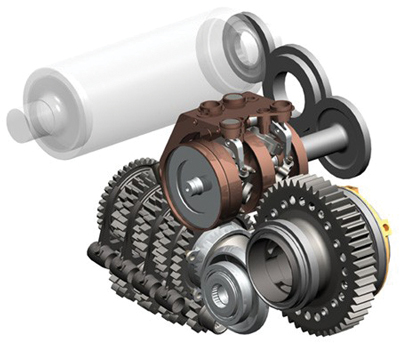
Formula One Racing (F1) is the sporting challenge between the greatest racing drivers in the world, but it is more than that. It is the showcase for the fastest and most technologically advanced racing cars in the world. Next year Formula One will see the introduction of KERS (www.autoblog.com/2008/04/23/ferrari-split-as-formula-onegoes-hybird/) — the Kinetic Energy Recovery System. The system stores the energy from braking and makes it available to the driver in an on demand burst. Due to the exceptional braking forces in braking an F1 car, the system must be called on to store a sizable amount of electricity.
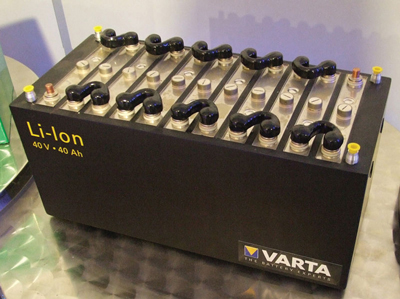
One of the primary safety concerns with hybrid and electric cars (aside from thermal runaway of the batteries, i.e., when handled improperly, some rechargeable batteries can experience thermal runaway resulting in overheating. Sealed cells will sometimes explode. Especially prone to thermal runaway are lithium-ion batteries (www.en.wikipedia.org/wiki/Lithium_ion_battery) is the potential for shocks with a high voltage battery on board. Formula One teams are currently developing kinetic energy recovery systems to provide hybrid drive capability for introduction in the 2009 season. Most are thought to be working with a flywheel based system but BMW Sauber is rumored to be developing an electric hybrid.
Several teams have had incidents with their systems including the Red Bull team that had a fire at their factory. A mechanic for the BMW got a nasty shock when he approached the BMW Sauber test car as it came into the pits during a recent test session and was knocked to the ground. Safety issues like this are one of the reasons why automakers take so much time in developing production systems. Amateurs do not staff the BMW Sauber F1 team. It has an annual budget in the hundreds of millions of dollars. The BMW experience illustrates that anyone involved with any hybrid or electric drive project needs to make sure to be very careful with the batteries or any activity involving the battery such as connecting a radio, meter or MDT terminal.[6]
Hal Morgan, TLPA Executive Vice President, submitted this article. He can be reached at (301) 984-5700 or hmorgan@tlpa.org.
[1] Some of this AFV information was adapted from a webinar “Green Fleet Vehicles – What You Should Know” sponsored by Merchants Leasing, Manchester, NH, October 25, 2007.
[2] Akasie, Jay. “Wave of the Future or Toy for 200 Environmentalists?” The New York Sun. June 17, 2008.
[3] Shenhar, Gabe. “Electric Cars Take Charge in Israel, Denmark” Consumer Reports Cars Blog. April 22, 2008.
[4] Krisher, Tom. “GM Engineer Says Rechargeable Car Is On Schedule” August 14, 2008, Forbes.com.
[5] Ulrich, Lawrence. “Diesel Automobiles Clean Up for an Encore” The New York Times, May 18, 2008.
[6] Abuelsamid, Sam. “Formula One to Phase in Kinetic Recovery System” April 21, 2008, Autoblogreen.com. and Korzeniewski, Jeremy. “BMW tries to Explain What Went Wrong with KERS in Testing” August 21, 2008, Autoblogreen.com.
© 2015 TLC Magazine Online, Inc. |